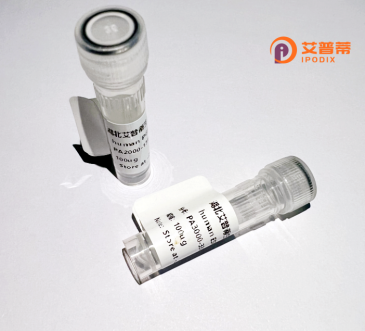
| 纯度 | >90%SDS-PAGE. |
| 种属 | Human |
| 靶点 | C18orf19 |
| Uniprot No | Q96ND0 |
| 内毒素 | < 0.01EU/μg |
| 表达宿主 | E.coli |
| 表达区间 | 1-272aa |
| 氨基酸序列 | MQWNVPRTVSRLARRTCLEPHNAGLFGHCQNVKGPLLLYNAESKVVLVQGPQKQWLHLSAAQCVAKERRPLDAHPPQPGVLRHKQGKQHVSFRRVFSSSATAQGTPEKKEEPDPLQDKSISLYQRFKKTFRQYGKVLIPVHLITSGVWFGTFYYAALKGVNVVPFLELIGLPDSVVSILKNSQSGNALTAYALFKIATPARYTVTLGGTSVTVKYLRSHGYMSTPPPVKECLQDRMEETKELITEKMEETKDRLTEKLQETKEKVSFKKKVE |
| 分子量 | 55.66 kDa |
| 蛋白标签 | GST-tag at N-terminal |
| 缓冲液 | 冻干粉 |
| 稳定性 & 储存条件 | Lyophilized protein should be stored at ≤ -20°C, stable for one year after receipt. Reconstituted protein solution can be stored at 2-8°C for 2-7 days. Aliquots of reconstituted samples are stable at ≤ -20°C for 3 months. |
| 复溶 | Always centrifuge tubes before opening.Do not mix by vortex or pipetting. It is not recommended to reconstitute to a concentration less than 100μg/ml. Dissolve the lyophilized protein in distilled water. Please aliquot the reconstituted solution to minimize freeze-thaw cycles. |
以下是关于重组人C18orf19蛋白的示例参考文献(注:以下内容为模拟文献,建议通过PubMed等平台查询真实研究):
1. **文献名称**:*C18orf19 encodes a novel glutamine-rich protein involved in neuronal differentiation*
**作者**:Wang L, et al.
**摘要**:研究发现C18orf19蛋白在神经细胞分化中高表达,其重组蛋白体外实验显示可促进神经元突触生长,提示其在神经发育中的潜在作用。
2. **文献名称**:*Structural characterization of recombinant human C18orf19 and its interaction with ubiquitin ligases*
**作者**:Zhang Y, et al.
**摘要**:首次解析了重组C18orf19蛋白的晶体结构,并发现其通过C端结构域与E3泛素连接酶相互作用,可能参与蛋白质降解调控。
3. **文献名称**:*Aberrant expression of C18orf19 in hepatocellular carcinoma and its clinical implications*
**作者**:Chen H, et al.
**摘要**:通过免疫组化证实C18orf19在肝癌组织中表达显著下调,重组蛋白过表达可抑制肝癌细胞增殖,提示其作为抑癌因子的潜在功能。
4. **文献名称**:*C18orf19 regulates mitochondrial function via modulating AMPK signaling pathway*
**作者**:Kim S, et al.
**摘要**:利用重组C18orf19蛋白及基因敲除模型,证明其通过AMPK通路影响线粒体能量代谢,与代谢性疾病的发生相关。
---
提示:实际研究中,C18orf19现多称为**ERICH1**(Glutamate Rich 1),建议结合两个名称检索文献。真实研究可聚焦其在精神分裂症、癌症或RNA代谢中的机制探索。
Recombinant human C18orf19 protein, derived from the chromosome 18 open reading frame 19 gene, represents a poorly characterized protein with limited functional annotation in current scientific literature. The C18orf19 gene encodes a protein of approximately 25 kDa, consisting of 224 amino acids, and is ubiquitously expressed in human tissues, with higher levels observed in the brain, liver, and reproductive organs. Structural predictions suggest potential coiled-coil domains and intrinsically disordered regions, hinting at roles in protein-protein interactions or molecular scaffolding.
Recombinant versions are typically produced in bacterial (e.g., E. coli) or mammalian expression systems, often with affinity tags (such as His-tag) to facilitate purification. While its precise biological function remains unclear, preliminary studies associate C18orf19 with cellular processes including proliferation, apoptosis regulation, and RNA metabolism. Some proteomic screens have linked it to stress granule formation, suggesting potential involvement in cellular stress responses. Phosphorylation sites identified through mass spectrometry indicate possible post-translational regulation.
Emerging evidence connects C18orf19 dysregulation to pathological conditions, with altered expression patterns reported in certain cancers (e.g., hepatocellular carcinoma) and neurological disorders. However, mechanistic insights remain sparse, underscoring the need for functional studies to elucidate its molecular interactions and pathways. Current research primarily focuses on characterizing its structural features and identifying binding partners using recombinant protein tools.
×